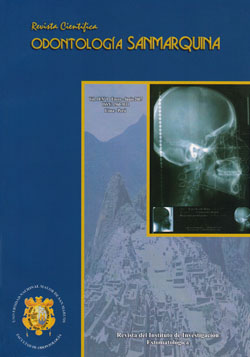Effectiveness of a preventive measure for children with cariogenic risk associated to salivary pH stability
DOI:
https://doi.org/10.15381/os.v10i1.2924Keywords:
Cariogenic risk, salivary pH, capacity buffer, oral hygiene.Abstract
Saliva is an etiological factor of caries. It acts stabilizing pH by its concentration of carbonates and phosphates. When the oral hygiene is deficient, pH becomes acid and optimal for the demineralization of teeth surfaces. If a diet rich in sugars and flour predominates, they become more acid and the risk of caries beginning is imminent. To determinate the behavior of salivary pH and demonstrate the effectiveness of the brushing as a low cost, efficient, easy application prevention measure, in children with cariogenic risk, samples of saliva of 44 children between 6 and 8 were taken, from San Martin de Porres district, before and after breakfast and analyzed with a potentiometer. GROUP 1: with old bacterial plaque (without previous tooth brashing) and GROUP 2: with recent bacterial plaque (with previous tooth brushing). According to “t” test analysis, the variation of pH salivary in both groups, before and after foods was statistically significant (p=0.000) but when comparing it between both groups 1 and 2, statistically significant differences did not exist. The removal of old and recent bacterial plaque is an essential preventive measure that is not related to the variation of pH salivary.Downloads
Downloads
Published
Issue
Section
License
Copyright (c) 2007 Margot Gutiérrez Ilave, Lita Ortiz Fernández, Katia Medina Calderón, Sylvia Chein Villacampa

This work is licensed under a Creative Commons Attribution-NonCommercial-ShareAlike 4.0 International License.
AUTHORS RETAIN THEIR RIGHTS:
a. Authors retain their trade mark rights and patent, and also on any process or procedure described in the article.
b. Authors retain their right to share, copy, distribute, perform and publicly communicate their article (eg, to place their article in an institutional repository or publish it in a book), with an acknowledgment of its initial publication in the Odontología Sanmarquina.
c. Authors retain theirs right to make a subsequent publication of their work, to use the article or any part thereof (eg a compilation of his papers, lecture notes, thesis, or a book), always indicating the source of publication (the originator of the work, journal, volume, number and date).






